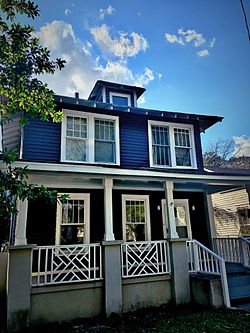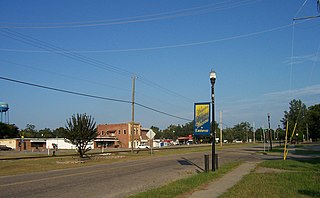
Eastover is a town in Richland County, South Carolina, United States. The population was 813 at the 2010 census, down from 830 in 2000. It is part of the Columbia, South Carolina, Metropolitan Statistical Area.

Benedict College is a private historically black college in Columbia, South Carolina. Founded in 1870 by northern Baptists, it was originally a teachers' college. It has since expanded to offer majors in many disciplines across the liberal arts. The campus includes buildings in the Benedict College Historic District, a historic area listed on the National Register of Historic Places.
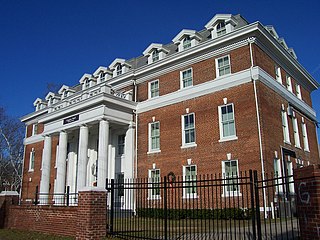
Allen University is a private historically black university in Columbia, South Carolina. It has more than 600 students and still serves a predominantly Black constituency. The campus is listed on the National Register of Historic Places as Allen University Historic District.

The Old Campus District, University of South Carolina, is a historic district centered on The Horseshoe on the main campus of the University of South Carolina in Columbia, South Carolina. On June 5, 1970, it was listed in the National Register of Historic Places. On April 19, 1996 MTV Unplugged filmed Hootie & the Blowfish's concert on The Horseshoe before the release of their second album Fairweather Johnson.

The James Petigru Boyce Chapel is a historic church building at 1306 Hampton Street in Columbia, South Carolina. It is a Greek Revival building built in 1859. A convention met here on December 17, 1860, whose delegates voted unanimously for South Carolina to secede from the United States, leading to the American Civil War. It was designated a National Historic Landmark as First Baptist Church, the role it played at the time. The building is part of the facilities complex of the First Baptist Church, Columbia- a Southern Baptist megachurch.

The Chappelle Administration Building, on the campus of Allen University in Columbia, South Carolina, was designed by John Anderson Lankford, known as the "dean of black architects." The building name has been spelled Chapelle Administration Building in HABS and NPS reports. It was declared a National Historic Landmark in 1976, cited as one Lankford's most important works.
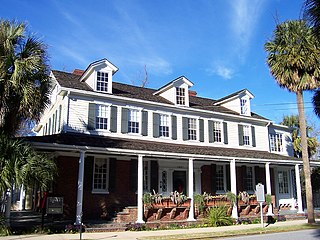
The Hale–Elmore–Seibels House or Seibels House is a historic building located in Columbia, South Carolina. Records of the exact year of its construction were destroyed in 1865 during the burning of the city by Union soldiers serving under General William Tecumseh Sherman. The best guess for the date of construction stems from a purported "1796" carved into a beam in the basement. Much of the early history of the house is uncertain, but it is thought to be the oldest building in Columbia.

Woodrow Memorial Presbyterian Church is a historic church in Columbia, South Carolina.

Charles C. Wilson was an American architect in practice in Columbia, South Carolina, from 1896 until his death in 1933.

Good Samaritan-Waverly Hospital, also known as “Good Sam” Hospital and Waverly Hospital, is a historic hospital for African-American patients located in Columbia, South Carolina. It was built in 1952, and is a two-story, brick building in the Moderne style. The hospital housed a pharmacy, laboratory, X-ray room, staff dining room, two operating rooms, and 50 beds to service the local community. The hospital closed in August 1973.
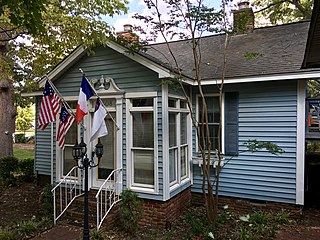
Old Shandon Historic District is a national historic district located at Columbia, South Carolina. The district encompasses 42 contributing buildings in a planned middle class residential development. They were built between the 1890s and 1950s, and the district includes examples of Queen Anne, Colonial Revival, Neoclassical Revival, and Craftsman/Bungalow style architecture. The district also includes the Shandon Baptist Church and Maple Street Southern Methodist Church.

Columbia Historic District II is a national historic district located at Columbia, South Carolina. The district encompasses 113 contributing buildings and 1 contributing site in a former residential section of Columbia. They were built between the early-19th century and the 1930s and are now mostly used for commercial purposes. The buildings are in the Greek Revival, Gothic Revival, Classical Revival, and the “Columbia Cottage” styles. Notable buildings include the Robert Mills House, Debruhl-Marshall House, Hampton-Preston House, Episcopal Church of the Good Shepherd, Crawford-Clarkson House, Maxcy Gregg House, Hale-Elmore-Seibels House, St. Paul's Lutheran Church, and Ebenezer Lutheran Church.

Allen University Historic District is a historic district in Columbia, South Carolina that includes buildings on the campus of Allen University, originally established as Payne Institute. Buildings in the district include Arnett Hall, the Chappelle Administration Building, Coppin Hall, the Joseph Simon Flippen Library, and the Canteen Building. The district was listed on the National Register of Historic Places April 14, 1975. The address is 1530 Harden Street. Originally in a suburb, the university is now near downtown.
Prior to the civil rights movement in South Carolina, African Americans in the state had very few political rights. South Carolina briefly had a majority-black government during the Reconstruction era after the Civil War, but with the 1876 inauguration of Governor Wade Hampton III, a Democrat who supported the disenfranchisement of blacks, African Americans in South Carolina struggled to exercise their rights. Poll taxes, literacy tests, and intimidation kept African Americans from voting, and it was virtually impossible for someone to challenge the Democratic Party, which ran unopposed in most state elections for decades. By 1940, the voter registration provisions written into the 1895 constitution effectively limited African-American voters to 3,000—only 0.8 percent of those of voting age in the state.

The Dr. Cyril O. Spann Medical Office, located in Columbia, South Carolina, served African-American patients during de jure and de facto racial segregation in the United States. Built in 1963, it was added to United States National Register of Historic Places on May 20, 2019.
Rev. James Myles Hinton, Sr. (1891–1970) was an American minister, businessperson, and civil rights leader. Hinton was a leader within the National Association for the Advancement of Colored People (NAACP) in South Carolina during the Jim Crow era in the 1940s and 1950s; he was a president of the local chapter, and served as the second president of the South Carolina Conference of Branches of the NAACP, from 1941 to 1958. In later life, Hinton served as the pastor at the Second Calvary Baptist Church in Columbia, South Carolina. In the 1940s and 1950s, he experienced harassment and violence from the Ku Klux Klan and/or other White supremacy organizations.
The Visanska-Starks House and Carriage House, built in 1900, is an example of the social history of Columbia, South Carolina's first suburb: Waverly Historic District. The history of the house includes Antebellum white, Jewish, and African-American inhabitants over several decades.
